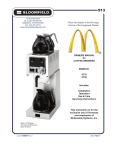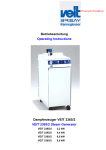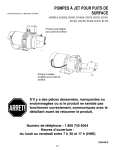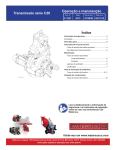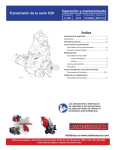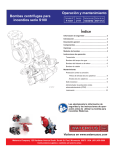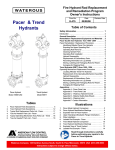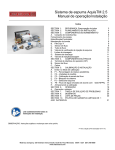Download Waterous PB18 Series Operating instructions
Transcript
PB18 Series Portable Pumps Operation, Maintenance and Overhaul Instructions Form No. F-2523 Issue Date Rev. Date 09/04 05/08/12 Table of Contents Read through the safety information and operating instructions carefully before using your Waterous Fire Pump. Safety Instructions . . . . . . . . . . . . . . . . . . . . . . . . . . . . . . . . . . 1 Warning and Operating Decals . . . . . . . . . . . . . . . . . . . . . . . 4 Preparation Before Operation . . . . . . . . . . . . . . . . . . . . . . . . 5 Operation Controls . . . . . . . . . . . . . . . . . . . . . . . . . . . . . . . . . . 6 Operation and Maintenance . . . . . . . . . . . . . . . . . . . . . . . . . . 7 Starting the Engine . . . . . . . . . . . . . . . . . . . . . . . . . . . . . . . . . . . 7 Priming Pump . . . . . . . . . . . . . . . . . . . . . . . . . . . . . . . . . . . . . . . . 7 Operating the Pump . . . . . . . . . . . . . . . . . . . . . . . . . . . . . . . . . . 8 Pumping from Hydrant or Relay . . . . . . . . . . . . . . . . . . . . . . . . 8 Pumping from Draft . . . . . . . . . . . . . . . . . . . . . . . . . . . . . . . . . . . 9 Engine Maintenance . . . . . . . . . . . . . . . . . . . . . . . . . . . . . . . . . . 9 Pump Maintenance . . . . . . . . . . . . . . . . . . . . . . . . . . . . . . . . . . . 9 Transmission Maintenance . . . . . . . . . . . . . . . . . . . . . . . . . . . . 9 Spark Arresting Muffler . . . . . . . . . . . . . . . . . . . . . . . . . . . . . . . . 9 Engine and Pump Repair . . . . . . . . . . . . . . . . . . . . . . . . . . . . . 9 Engine Repair . . . . . . . . . . . . . . . . . . . . . . . . . . . . . . . . . . . . . . . 9 Pump Repair . . . . . . . . . . . . . . . . . . . . . . . . . . . . . . . . . . . . . . . . 9 Overhaul Instructions - Direct Mounted Pump . . . . . . . . 10 Priming Tube Removal . . . . . . . . . . . . . . . . . . . . . . . . . . . . . . . 10 Volute Body Removal . . . . . . . . . . . . . . . . . . . . . . . . . . . . . . . . 10 Impeller Removal . . . . . . . . . . . . . . . . . . . . . . . . . . . . . . . . . . . . 11 Mechanical Seal Removal . . . . . . . . . . . . . . . . . . . . . . . . . . . . 11 Engine Adapter Assembly Removal . . . . . . . . . . . . . . . . . . . . 12 Overhaul Instructions - Geared Pump . . . . . . . . . . . . . . . 13 Volute Body Removal . . . . . . . . . . . . . . . . . . . . . . . . . . . . . . . . 13 Impeller Removal . . . . . . . . . . . . . . . . . . . . . . . . . . . . . . . . . . . . 13 Gear Case Cover Removal . . . . . . . . . . . . . . . . . . . . . . . . . . . 14 Impeller Shaft Assembly . . . . . . . . . . . . . . . . . . . . . . . . . . . . . . 14 Drive Gear Removal . . . . . . . . . . . . . . . . . . . . . . . . . . . . . . . . . 15 Gear Case Removal . . . . . . . . . . . . . . . . . . . . . . . . . . . . . . . . . 15 Mechanical Seal Assembly . . . . . . . . . . . . . . . . . . . . . . . . . . . 16 Inspection . . . . . . . . . . . . . . . . . . . . . . . . . . . . . . . . . . . . . . . . . 17 Impeller Wear . . . . . . . . . . . . . . . . . . . . . . . . . . . . . . . . . . . . . . . 17 Mechanical Seal . . . . . . . . . . . . . . . . . . . . . . . . . . . . . . . . . . . . 17 Oil Seals . . . . . . . . . . . . . . . . . . . . . . . . . . . . . . . . . . . . . . . . . . . 17 Ball Bearings, Gears and Needle Bearing . . . . . . . . . . . . . . . 17 Reassembling and Testing Pump . . . . . . . . . . . . . . . . . . . . 18 Direct Mounted Pump . . . . . . . . . . . . . . . . . . . . . . . . . . . . . . . . 18 Geared Pump . . . . . . . . . . . . . . . . . . . . . . . . . . . . . . . . . . . . . . . 18 Testing . . . . . . . . . . . . . . . . . . . . . . . . . . . . . . . . . . . . . . . . . . . . . 18 Troubleshooting . . . . . . . . . . . . . . . . . . . . . . . . . . . . . . . . . . . 19 All content in this instruction is property of the Waterous Company. Instructions subject to change without Visit us at www.waterousco.com Waterous Company 125 Hardman Avenue South, South St. Paul, Minnesota 55075 USA (651) 450-5000 Instructions subject to change without notice. SAFETY INSTRUCTIONS Page 1 of 20 The PB18 Series Portable Pump is designed and intended for use as portable firefighting equipment. DANGER ! Exhaust gas hazard. Can cause illness or death. Do not run the engine in an enclosed area. Exhaust gases contain carbon monoxide, an odorless, deadly poison. DANGER ! Fire or explosion hazard. Can cause personal injury or death. A fire or explosion may result if the following instructions are not followed: 1. DO NOT remove fuel tank cap nor fill fuel tank while engine is hot or running. (Allow engine to cool two minutes before refueling.) 2. If gasoline is spilled, move machine away from the area of the spill and avoid creating any source of ignition until the gasoline has evaporated. 3. DO NOT STORE, SPILL OR USE GASOLINE NEAR AN OPEN FLAME, or devices such as a stove, furnace or water heater which utilize a pilot light, or devices which can create a spark. 4. Refuel outdoors or only in well ventilated areas. 5. DO NOT OPERATE ENGINE WITHOUT A MUFFLER. Inspect muffler periodically and replace, if necessary. 6. DO NOT use this unit on forest covered, brush covered or grass covered unimproved land unless the spark arrester is attached to the muffler. 7. DO NOT operate the engine with an accumulation of grass, leaves or other combustible material under, around or behind the muffler. 8. DO NOT operate the engine if air cleaner or cover directly over the carburetor air intake is removed. 9. DO NOT choke carburetor to stop the engine. 10. DO NOT check for spark with spark plug removed (use an approved tester). 11. DO NOT crank engine with spark plug removed. (If the engine floods, place throttle in “FAST” and crank until engine starts.) 12. DO NOT use the pump to pump flammable liquids. ! WARNING Death or serious personal injury might occur if proper operating procedures are not followed. The pump operator, as well as individuals connecting supply or discharge hoses to the apparatus must be familiar with these pump operating instructions as well as other operating instructions and manuals for the apparatus, water hydraulics and component limitation. ! WARNING Pressure Hazard. May result in personal injury. Prior to connection or removal of hoses, caps or other closures with pump intake or pump discharge connec‐ tions, relieve pressure by opening drains. SAFETY INSTRUCTIONS Page 2 of 20 ! WARNING Scalding Water Hazard. May result in serious burns. When operating the pump, be sure to open at least one discharge valve slightly to prevent the pump from overheating. If the pump runs for a few minutes completely closed, it may heat the water enough to scald someone when the valve is opened. Overheating can damage the packing, seals and other pump parts. If the apparatus builder has installed a by-pass system or other provision designed to prevent overheating, opening a discharge valve may be unnecessary. ! WARNING Suction and high pressure hazard. May cause injuries to the hands, fingers or severe cuts or abrasions to the skin. Never insert hands or fingers into the intake or discharge openings while engine is running. Never spray high pressure water at a person or animal. CAUTION Pump overheat hazard. May cause damage to the pump. Do not run the pump dry for any extended period of time to prevent the pump from overheating. IMPORTANT NOTES: 1. Ambient operating temperature range: -18_F to 118_F (-28_C to 48_C) 2. Maximum sound pressure level: 94 dBa @ 1.5 meters 3. The PB18 Series Portable Pumps are designed to be carried by two or more people. SAFETY INSTRUCTIONS Page 3 of 20 ! WARNING Accidental starting hazard. May cause personal injury to the hand, arm or feet. Prevent accidental starting by removing the spark plug wire and grounding it when servicing the engine or equipment. Disconnect negative wire from the battery terminal if equipped with electric starting system. ! WARNING Excessive speed notice. May cause personal injury. Operating an engine at excessive high speeds increases the danger of personal injury. Do not tamper with the governor springs, governor links or other parts which may cause an increase in governed engine speed. Do not tamper with the engine speed selected by the original equipment manufacturer. ! WARNING Moving or rotating parts hazard. May cause personal injury. Always keep hands and feet clear of moving or rotating parts to prevent injury. ! WARNING High temperature components. May cause severe burns. Do not touch hot mufflers, cylinders or fins as contact may cause burns. ! WARNING Kickback notice. May cause injury to hand or arm. To prevent hand or arm injury, pull the cord slowly until resistance is felt then pull the starter cord rapidly to avoid kickback. ! CAUTION Spark arrestor notice. This engine is equipped with a spark arrestor for use on forest covered, brush covered or grass covered unimproved land, it must be maintained in effective working order by the operator. In the state of California, the above is required by law (Section 4442 of the California Public Resources Code.) Other states may have similar laws. ! WARNING DO NOT strike the flywheel with a hammer or hard object as this may cause the flywheel to shatter in operation. Use correct tools to service the engine. ! WARNING Equipment Tipping Hazard. May cause personal injury or equipment damage. DO NOT run the engine if the equipment is not stable and tipping can occur. Mount equipment to a stable base. If pump is hand carried, place the pump on a firm, level surface to operate. Maximum operating slope is 15_. WARNING LABELS Page 4 of 20 Figure 1. Warning Labels IL2366 PREPARATION BEFORE OPERATION Page 5 of 20 Figure 2. Preparation Before Operation Operator Panel Fuel Fill Connect Intake Hose Connect Discharge Hose Close Pump Drain (Drain behind rail) OPERATION CONTROLS Page 6 of 20 Figure 3. Operation Controls Pump Drain (Located at bottom of volute) Engine Exhaust Oil Fill Fuse Engine Speed Control (Throttle) Fuel Fill Panel Light Switch Panel Light Priming Knob Intake Pressure Low Oil Pressure Indicator Ignition Switch (OFF-RUN-ST ART) Discharge Pressure Auxiliary 12 VDC Power Connection Mating Connector: SwitchcraftR EN3C2F16C (Not Furnished by Waterous Company) IL2366 Page 7 of 20 Preparation Before Operation (See Figure 2) Symbols This safety alert symbol indicates that this message involves personal safety. Words danger, warning and caution indicated de‐ gree of hazard. Death, personal injury and/‐ or property damage may occur unless in‐ structions are followed carefully. You are not ready to operate this engine if you have not read and understood the fol‐ lowing safety items. Read this entire owner/‐ operator manual and the operating instruc‐ tions of the equipment this engine powers. Note: Engines and transmissions are shipped with oil. Check oil level before operating. 1. Inspect the unit carefully for damage resulting from shipment. Abusive handling during shipment resulting in obvious damage to the engine or the pump may cause rubbing of moving parts resulting in severe en‐ gine or pump damage if operation is attempted. OPERATION AND MAINTENANCE ! WARNING Low oil. May result in engine power loss, personal injury or property damage. Maintain correct oil level. Check oil level each time engine is refueled. Low oil level may cause loss of engine power and may result in personal injury or property damage. Connections between the pump and intake and discharge hoses or piping should be made leakproof. Wrench torque should be limited to 80 ft. lb. maximum when making con‐ nections. If more than 80 ft. lb. torque is required, use two wrenches, one wrench on the pump intake or discharge fitting and one wrench on the hose or pipe being attached. Balancing the torque applied between the two wrenches will avoid excessive forces to the pumping unit. When pumping units are permanently mounted in an ap‐ paratus and attached to rigid piping, connections between the pump and the piping should be made using flexible couplings to avoid applying excessive forces to the pump. Starting the Engine (See Figure 3) 2. Check the unit for bolts or other fasteners which may have vibrated loose during shipment. 1. Refer to the Briggs & Stratton Operation & Mainte‐ nance Instructions. 3. These units are equipped to use a type 12N14-3A ``motorcycle” battery. 2. Move the choke control lever to the “CHOKE” posi‐ tion. Battery Specifications: • Capacity - 14 Amp Hour • Approximately 130 cold cranking amps • Size: 3-1/2 x 5-1/4 x 6-1/2 tall 4. Prepare the engine for starting by reading completely and following the Briggs and Stratton Operation and Maintenance Instructions. 5. Fill engine with oil per Briggs & Stratton instructions. The PB18 Series Portable Pumps use Briggs & Strat‐ ton Model 350477 Series engines. 6. Fill fuel tank. Use clean, fresh, lead-free gasoline with a minimum of 85 octane. (See Briggs & Stratton in‐ structions for more detail.) The engine should be re‐ fueled prior to use to avoid the need to refuel when it is hot. 7. Fill transmission with 1 pint of SAE 90W oil through top plug or breather elbow. Remove oil level plug to check oil level (gear driven pump only). 8. With the ignition switch OFF, rotate the engine crank‐ shaft several times with the rewind start rope to make sure the engine and pump turn over freely with no abnormal rubbing noises. 3. Move the throttle control to the “FAST” position. 4. Rotate ignition switch to the “RUN” position. 5. Rotate and hold the ignition switch in the “START” position to operate the starter motor relay and start engine. (Alternate: Use manual rope start.) 6. After the engine starts, return the ignition switch to the “RUN” position, return the choke control to the “RUN” position and adjust the throttle as required. Priming the Pump The PB18 Series utilize an exhaust primer. 1. Connect intake and discharge hoses or piping. 2. Close the discharge valve if so equipped. 3. Start engine and advance the throttle to “FAST” posi‐ tion. 4. Pull the priming knob located at the top of the engine to “PRIME” position. Alternate: Pull the primer lever and advance the throttle. 5. Operate primer until water is ejected from it. OPERATION AND MAINTENANCE Page 8 of 20 6. Return the priming lever to the “RUN” position. Pumping from Water Tank 7. Open the discharge valve if so equipped. 1. Open valves in piping between water tank and pump intake, and the discharge valve. When a PB18 pump is used from draft in below freezing weather, the following shut-down procedure should be used: 1. When pumping is completed and discharge hose dis‐ connected, move the priming lever to the “PRIME” position to drain the intake and the priming line back into the water supply. 2. Disconnect the intake hose. Start the engine and op‐ erate the primer until no more water comes out. 3. Stop the engine and open the volute drain. Operating the Pump The pump performance can be varied by: 1. Controlling a discharge valve or nozzle. Opening the valve increases flow and decreases discharge pres‐ sure. 2. Controlling engine speed via the throttle control. In‐ creasing the engine speed increases the discharge pressure and flow. ! WARNING Pump Overheating. May cause personal injury or pump damage. When operating the pump, be sure to open the dis‐ charge valve slightly to prevent the pump from over‐ heating. If the pump runs even for a few minutes completely closed it may heat the water enough to scald someone when the valve is opened. Overheating can damage the seals and other pump parts. CAUTION Freezing water hazard. May cause damage to the pump. If the pump is exposed to freezing temperatures, drain all water from pump, lines and accessories. ! WARNING Pressure Hazard. May cause personal injury. When the pump stops there is no stored pressure but there could be pressure in the hoses. Use care when disconnecting hoses and allow any residual pressure to bleed off before uncoupling. 2. Allow about 30 seconds for water to flow into pump. Note: Priming the pump may be necessary under some conditions because of the air trapped in pump and piping. 3. Adjust engine speed and discharge nozzle or valve to obtain desired discharge pressure and flow. CAUTION Do not attempt to pump more water than is available from water tank. Always make sure the intake pressure gauge reading stays above zero. After Pumping 1. Stop engine. 2. If pumping anything but clean water, open all valves and open all drains. Flush entire system with clean, fresh water for several minutes to remove all traces of impurities. 3. Close all drains and install intake and discharge caps. 4. Operate primer lever to drain any fluid from the prim‐ ing pump. Pumping from Hydrant or Relay 1. Start Engine. 2. Open intake, hydrant and other valves as necessary to allow water to enter the pump. CAUTION Pump has a mechanical seal, limit intake pressure to 75 psi if possible. Although the pump will operate properly with higher intake pressure, such operation will greatly acceler‐ ate mechanical seal wear. 3. Open the discharge valve and increase engine speed to obtain desired discharge pressure and capacity. CAUTION Do not attempt to pump more water than is available from the hydrant or relaying pumper. Make sure the intake pressure gauge reading stays above zero. Some fire departments operate at a minimum intake pressure of 10 psi when pumping from hydrant or in relay to prevent a “soft” intake hose from collapsing. Page 9 of 20 OPERATION AND MAINTENANCE After Pumping (See “Pumping from Tank” above) After Pumping (See “Pumping from Tank” above) Pumping from Draft Engine Maintenance Note: To get full capacity, quick prime and maintain pump efficiency: Refer to Briggs and Stratton Operation and Maintenance Instructions. a.) Position truck as near as possible to water supply. Pump Maintenance b.) Avoid humps or sharp bends in intake hose. Make sure no part of hose is higher than pump intake inlet. (Air pockets in intake hose may cause loss of prime or erratic pump action and may reduce pump capacity.) The pump requires no maintenance other than draining the volute body after each use. If the pump has been han‐ dling chemicals, salt water or dirty water, flush entire sys‐ tem with clean, fresh water for several minutes to remove all traces of impurities. c.) Make sure all intake connections are tight and dis‐ charge valves are closed. Transmission Maintenance d.) Immerse intake strainer at least two feet below water surface to prevent pump from drawing air (Whirlpools forming above intake strainer indicate that strainer is too close to surface of water). (PB18G Gear Case Models Only) e.) Make sure intake strainer is far enough from bottom to prevent pumping sand, gravel or other foreign matter. Spark Arresting Muffler 1. Prime the pump (see separate). 2. Open discharge valves and increase engine speed to obtain desired discharge pressure and capacity. Drain and refill with one pint SAE 90 weight gear oil after 100 hours of operation or one year. Every 100 hours, examine the spark arrestor located in‐ side the exhaust primer adapter. Clean screen or replace if damaged. Removal of the spark arrestor will require removal of the butterfly assembly from the primer adapter. ENGINE AND PUMP REPAIR Repairs to be done during the Waterous or Briggs and Stratton warranty period must be done in accordance with the appropriate warranty policy. Engine Repair If engine service or repair is needed, refer to Briggs and Stratton Operation and Maintenance Instructions. NOTE: The control panel, primer, spark arrestor and muffler are not furnished by the engine manufacturer. Refer to Water‐ ous Company Service Parts List supplied with the pump for these parts. Pump Repair Pump repair should be done by Waterous authorized ser‐ vice personnel. Alternatively, parts can be purchased from Waterous Company and installed by any mechanic famil‐ iar with pump overhaul and repair practices and procedu‐ res. Service Parts Lists are provided which give part de‐ scriptions and part Reference Numbers for ordering. Be sure to give pump model and serial number and Parts List number when ordering parts. OVERHAUL - DIRECT MOUNTED PUMP Page 10 of 20 Figure 3. Priming Tube Removal 1. Disconnect any intake and discharge piping. It may not be necessary to remove intake or dis‐ charge adapters or discharge valve. IL2365 2. Disconnect the tube that attaches the priming valve to the inlet of the pump. Figure 4. Volute Body Removal Hex Hd Screw, 3/8-16 x 2 in. Lock Washer, 3/8 in. The muffler and control panel assembly is shown removed for clarity. IL1315 3. Remove (4) hex hd screws and wash‐ ers from the engine side of the pump volute body. Slide the volute body off the adapter attached to the engine. 4. Remove wear ring if required. Volute Body Assembly with Wear Ring OVERHAUL - DIRECT MOUNTED PUMP Page 11 of 20 Figure 5. Impeller Removal Square Key, 1/4 x 3/4 in. SS Impeller Socket Hd Screw, 3/8-24 x 1 in. 5. Remove the socket head cap screw and washer holding the impeller to the en‐ gine crankshaft. 6. If the impeller does not pull off the shaft easily, 1/4-20 puller holes are provided in the impeller to assist in removal. Be sure to protect the tapped hole in the shaft when using any type of puller. 7. Remove the impeller key. Figure 6. Mechanical Seal Removal Mechanical Seal 8. Remove the mechanical seal rotating parts. The stationary seal ring will remain in the pump adapter. IL1316 OVERHAUL - DIRECT MOUNTED PUMP Page 12 of 20 Figure 7. Engine Adapter Assembly Removal O-ring Copper Washer, 3/8 in. Socket Hd Screw, 3/8-16 x 2 in. Mechanical Seal Stationary Seal Ring IL1318 Shaft Sleeve Engine Adapter Assembly O-ring 9. Remove the (4) socket head cap screws and wash‐ ers holding the engine adapter to the engine. 10. Remove the engine adapter. 11. Press out the mechanical seal stationary ring. 12. Remove the engine adapter O-ring. 13. Remove wear ring if required. 14. Remove the shaft sleeve and O-ring. Wear Ring OVERHAUL - GEARED PUMP Page 13 of 20 Figure 8. Volute Body Removal - Geared Pump Hex Nut, 7/16-20 Lock Washer, 7/16 in. The muffler and control panel assembly is shown removed for clarity. Hex Hd Screw, 7/16-20 x 2-3/4 in. Hex Hd Screw, 7/16-20 x 3 in. IL2360 1. Remove (4) hex head screws from the pump volute body. Slide the volute body off the gear case cover. Wear ring will come off with volute. Remove if re‐ quired. Figure 9. Impeller Removal - Geared Pump 2. Remove impeller nut and washer from the impeller shaft. If the impeller does not pull off the impeller shaft easily, use a gear puller or two pry bars be‐ tween the impeller and adapter. The mechanical seal bellows assembly and primary ring will come off with the impeller. Remove the bellows and primary ring from the impeller hub. Remove the impeller key. NOTE: The stationary seal ring will remain with the gear case cover. 3. Drain oil from gear case. Square Key, 3/16 x 1 in., SS Impeller Wear Ring Nord-Lock r Washer, 1/2 in. (used after 09/08/04) IL2361 Impeller Nut Magnetic Pipe Plug, 3/8 in. Mechanical Seal Flat Washer, 1/2 in., SS (used prior to 09/08/04) OVERHAUL - GEARED PUMP Page 14 of 20 Gear Case Cover Figure 10. Gear Case Cover Removal 1. Remove the impeller gasket. Gear Case Gasket 2. Remove the (10) hex head screws and lock washers from the gear case cover. Oil Seal 3. Remove the gear case cover from the gear case. Press out the impeller shaft and bear‐ ing assembly from the gear case cover. Impeller Shaft and Bearing Assembly 4. Remove gear case gasket. 5. Press out the mechanical seal stationary seal ring, oil seal. Pull wear ring if required. Stationary Ring O-ring Impeller Gasket (used after 09/08/04) Wear Ring Lock Washer, 3/8 in. Hex Hd Screw, 3/8-16 x 1 in. IL2362 Needle Bearing (In gear case) Figure 11. Impeller Shaft Assembly - Geared Pump Inner Race Impeller Shaft / Driven Gear 6. The impeller shaft assembly with the ball bearing should not require dis‐ assembly unless inspection reveals wear of the ball bearing. 7. Using a suitable sleeve, press the bearing off the impeller end of the shaft. IL1898 Ball Bearing OVERHAUL - GEARED PUMP Page 15 of 20 Figure 12. Drive Gear Removal Drive Gear Square Key, 1/4 x 1 in. 8. Remove the hex head screw and washers that hold the drive gear to the engine crankshaft. IL1323 9. Pull the drive gear off the shaft. CAUTION Do not damage the internal thread of the shaft. Washer 10. Remove the key. Hex Hd Screw, 3/8-24 x 1-1/8 in. Gear Case Subassembly Figure 13. Gear Case Removal O-ring Oil Seal Shaft Sleeve 11. Remove the (4) socket head cap screws and washers holding the gear case to the engine. 12. Remove the gear case. Press out the shaft seal. 13. If oil has been leaking past the shaft sleeve, the O-ring and oil seal should be replaced. Remove the sleeve. Do not mar the sleeve sur‐ face under the seal. 14. Clean the magnetic drain plug and check to be sure the breather is not plugged. IL1324 Flat Copper Washer, 3/8 in. Socket Head Screw, 3/8-16 x 1-1/4 in. OVERHAUL - GEARED PUMP Page 16 of 20 Figure 14. Mechanical Seal Assembly - Geared Pump Nord-Lock R Washer (see Detail A) Sealing Surface Chamfered Edge Primary Ring Impeller Gasket Stationary Ring O-Ring Bellows Assembly IL2266 INSPECTION Page 17 of 20 After the pump has been disassembled, check the following before reassembly: Impeller Wear Oil Seals 1. Check the wear hubs on the impeller for excessive wear, or clearance with the wear rings. If the clear‐ ance exceeds 0.020/0.025in., or if the impeller hubs are badly scored or grooved, replace the impeller and both wear rings. Tapped holes are provided in each wear ring to aid in removing them. Check the impeller shaft and engine crankshaft sleeve for signs of severe wear from the oil seal. Ball Bearing, Gears and Needle Bearing Check for severe wear and replace as necessary. 2. Check all O-rings for cuts,nicks, or other damage. Mechanical Seal 1. When a mechanical seal is removed, it must be re‐ placed. 2. Check the shaft sleeve in the area under the mechani‐ cal seal bellows to be sure it is free of severe scratches or other damage. On geared pumps, check the impeller hub in the area under the mechanical seal to be sure it is free from scratches or other dam‐ age. Note: Discard spring retainer if included with mechanical seal. Figure 15. Mechanical Seal Installation If lubricant or other foreign material should get on the sealing surfaces, wipe it off with denatured alcohol and a lint-free cloth. Note: On direct mounted pumps bellows assembly rides on shaft sleeve. On geared pumps, the bellows assemlby rides on the impeller hub. Note: If Waterous Mechanical Seal Lubricant part no. 52608 is not available, P80 rubber lubricant, straight dish soap or glycerin may be substi‐ tuted. Coat inside of bellows before installing. Use a water-based lubricant. Elastomer bellows must slide over shaft to seat with stationary ring. IL2368 Coat O-ring with oil before installing in head. Surface opposite O.D. chamfer must face primary ring. Lubricate shaft or shaft sleeve before installing bellows assembly. Use a water-based lubricant. REASSEMBLING AND TESTING PUMP Page 18 of 20 Reassembling the pump is basically the reverse of disas‐ sembly. The following guidelines will help in reassembly. when the impeller or drive gear is tightened onto the shaft. 1. Check the engine crankshaft for any corrosion deposits that will interfere with seating and sealing of the shaft sleeve. 4. When installing mechanical seal stationary ring, be care‐ ful not to scratch the sealing surface that contacts the polished carbon sealing ring. 2. Lubricate all O- rings when installing. 5. 3. The shaft sleeve should seat down tight against the shoulder of the engine crankshaft. It may ”pop” back slightly on initial installation, but will seat down tight When installing new wear rings, press them into the bores carefully so they seat down square at the bottom of the bore. Coat O.D. with a Never Seize type product. Direct Mounted Pump primary ring with a soft cloth and denatured alcohol. Install bellows assembly onto impeller shaft with primary ring facing the stationary ring. Push bellows assembly until primary ring contacts stationary ring. Note: Discard spring retainer if included with mechanical seal. 1. Lubricate the crank shaft with light oil. Carefully install O- ring followed by the shaft sleeve. Be sure there are no burrs on the end of the sleeve. 2. Install new wear ring if required in pump adapter and volute body. 3. Install the mechanical seal stationary ring in the pump adapter, being careful not to scratch the sealing sur‐ faces. Clean sealing surface with a soft cloth and dena‐ tured alcohol. 6. Mount pump adapter to engine. Replace the sealing washers under the socket head cap screws that secure the pump adapter to the engine, if they show signs of being badly bowed, cracked or corroded. Install the impeller. Make sure it is seating tight against the shaft sleeve by checking for any gap where the sleeve seats against the engine crankshaft shoulder. These surfaces should be tight together with no gap. 7. Complete reassembly of the pump and any fittings pre‐ viously removed. 4. 5. Clean crank shaft. Lubricate shaft and inside diameter of bellows assembly with water based lubricant. Clean Geared Pump 1. Install O- ring and shaft sleeve on engine crank shaft oil seals into gear case. Lubricate the crank shaft with light oil. Carefully install O- ring followed by the shaft sleeve. Be sure there are no burrs on the end of the sleeve. 2. Before installing an oil seal in a housing, apply a thin coat of sealant to housing oil seal seat. (Waterous recommends Loctite Ultra Blue RTV Silicon Sealant to Permatex Super 300). Be sure that the seal, shaft and gear case are clean. Always install a seal with the seal lip facing in. Apply force to the outer edge of the seal and press in evenly. 7. Insert the impeller shaft assembly in the gear case cov‐ er. Be sure that the retaining ring is secure in the groove on the shaft, and that the gear spacer is in place. 8. Using a new gasket, place the gear case cover adapter on the gear case and replace the ten hex head screws and lock washers. 9. Install the impeller gasket. 10. Clean impeller shaft. Lubricate impeller hub and inside diameter of bellows assembly with water based lubri‐ cant. Install bellows assembly onto impeller hub with primary ring facing the stationary ring. Push bellows assembly until primary ring contacts iimpeller hub shoul‐ der. Clean primary ring with a soft cloth and denatured alcohol. 3. Position the gear case over the shaft sleeve on the en‐ gine and replace the four socket head cap screws and washers. Inspect and replace washers as necessary. 4. Insert the key, gear, hex head and washers on the en‐ gine crankshaft. Tighten screw securely. 11. Install the key and then the impeller on the shaft. 5. Install the mechanical seal stationary ring and oil seal in the gear case cover adapter, being careful not to scratch the sealing surfaces. Clean sealing surface with a soft cloth and denatured alcohol. 12. Install the Nord- LockR washer (see Detail A of Figure 14) and impeller nut. Tighten nut. 13. Press new wear ring if required into the volute. 14. Place the volute over the lubricated O- ring of the adapt‐ er and replace the 4 bolts, nuts and lock washers. 15. Complete reassembly of the pump and any fittings pre‐ viously removed. 6. Install new wear rings if required, in gear case cover and volute body. Testing 1. Before testing the pump, rotate the engine crankshaft with the engine starter or rope. Spark plugs should be disconnected. Be sure there are no abnormal rubbing noises. 2. The mechanical seal may leak when the pump is first run after it has been repaired. This leakage should stop after the seal faces run- in. 3. With the pump running, check for unusual noises or leaks at volute joints, adapter/gear case engine screws, or shaft sleeve. These should be corrected before the pump is returned to service. TROUBLESHOOTING Page 19 of 20 CONDITION POSSIBLE CAUSE SUGGESTED REMEDY Priming line Open the priming line petcock at the suction inlet of the pump body when priming. petcock closed Air leaks Clean and tighten all intake connections. Make sure intake hoses and gaskets are in good condition. Use the following procedure to locate air leaks: 1. Connect intake hose to pump and attach intake cap to end of hose. 2. Close all pump openings. 3. Start engine and advance throttle to “FAST” position. 4. Pull the priming lever to “PRIME” position until intake pressure gauge indicaates 22 in. Hg (If primer fails to draw specified vacuum, it may be defective, or leaks are too large for primer to handle). 5. Return the priming lever to the “RUN” position and shut off engine. If vacuum drops more than 10 in. Hg in 5 minutes, serious air leaks are indicated. With engine stopped, air leaks are frequently audible. If engine leaks cannot be heard, apply engine oil to suspected points (intake hose connections, piping joints, mechanical seal) and watch for break in film or oil being drawn into pump. Completely fill water tank (if so equipped). Connect intake hose to hydrant or auxiliary pump. Open one discharge valve and run in water until pump is completely filled and air is expelled. Close discharge valve, apply pressure to system and watch for leaks or overflowing water tank. A pressure of 100 psi (8.6 bar) is sufficient. DO NOT EXCEED RECOMMENDED PRESSURE. Air trapped in pump and piping Pump fails to prime or loses prime When pumping from a water tank, priming the pump may be necessary under some conditions because of air trapped in pump and piping. Remove all leaves, dirt and other foreign material from intake strainer. Dirt on intake strainer When drafting from shallow water source with mud, sand or gravel bottom, protect intake strainer by suspending it from a log or other floating object to keep it off the bottom. Anchor float to prevent it from drifting into shallow water. Defective primer After prolonged service, the engine muffler, spark arrestor or exhaust primer may be come plugged with carbon deposits or rust. Disassemble and clean or replace compon ents as required. Engine speed too low Advance throttle to “FAST” position. Bypass line open If a bypass line is installed between the pump discharge and water tank to prevent pump from overheating with all discharge valves closed, look for check valve in the line. If the valve is stuck open, clean it, replace it or temporarily block off line until a new valve can be obtained. Lift too high Reduce the vertical distance between the water source and the pump intake. End of intake hose not sub merged deep enough. Although intake hose might be submerged enough for priming, pumping large volumes of water may produce whirlpools, which will allow air to be drawn into intake hose. Whenever possible, place end of intake hose at least two feet (.6 m) below water source. High point in intake line If possible, avoid placing any part of intake hose higher than pump inlet. If high point cannot be prevented, close discharge valve as soon as pressure drops, and prime again. This procedure will usually eliminate air pockets in line, but it may have to be repeated several times. Primer not operated long enough The maximum time for priming should not exceed 45 seconds for lifts up to 10 feet (3m). TROUBLESHOOTING CONDITION Insufficient capacity Insufficient pressure (In general, the above causes and remedies for insufficient pump capa city will also apply to insufficient pump pressure.) POSSIBLE CAUSE Page 20 of 20 SUGGESTED REMEDY Insufficient engine power Engine requires maintenance. Check engine in accordance with manufacturer's instruction. Pump impeller or wear rings badly worn Check the wear hubs on the impeller for excessive wear, or clearance with the wear rings. If the clearance exceeds 0.020/0.025 in., or if the impeller hubs are badly scored or grooved, replace the impeller and both wear rings. Intake strainer or impeller vanes fouled with debris Remove intake strainer and hose and clear away all debris. Pressure backwash will usually clear impeller vanes when pump is stopped. Intake hose defective On old intake hoses, the inner liner sometimes becomes so rough it causes enough friction loss to prevent pump from drawing capacity. Sometimes, the liner will separate from the outer wall and collapse when drafting. It is usually impossible to detect. Intake hose too small When pumping at higher than normal lifts, or at high altitudes, use a larger intake hose. Intake hose too long Position pump as near as possible to water supply. Engine speed too low Check engine speed with a tachometer. If speed is too low, refer to engine manufacturer's instructions for method of adjusting engine speed control. Pump capacity limits pump pressure Do not attempt to pump greater volume of water at desired pressure than the pump is designed to handle. Exceeding pump capacity may cause a reduction in pressure. Exceeding maximum recommended capacity will produce cavitation, and will seriously impare pump efficiency. When pumping from water tank, hydrant or relay, always make sure the intake pressure gauge reading stays above zero. WATEROUS COMPANY ••125 HARDMAN AVENUE SOUTH SOUTH ST. PAUL, MINNESOTA 55075-2456 U.S.A. Phone: (651) 450-5000 • FAX: (651) 450-5090 Web Site: www.waterousco.com






















